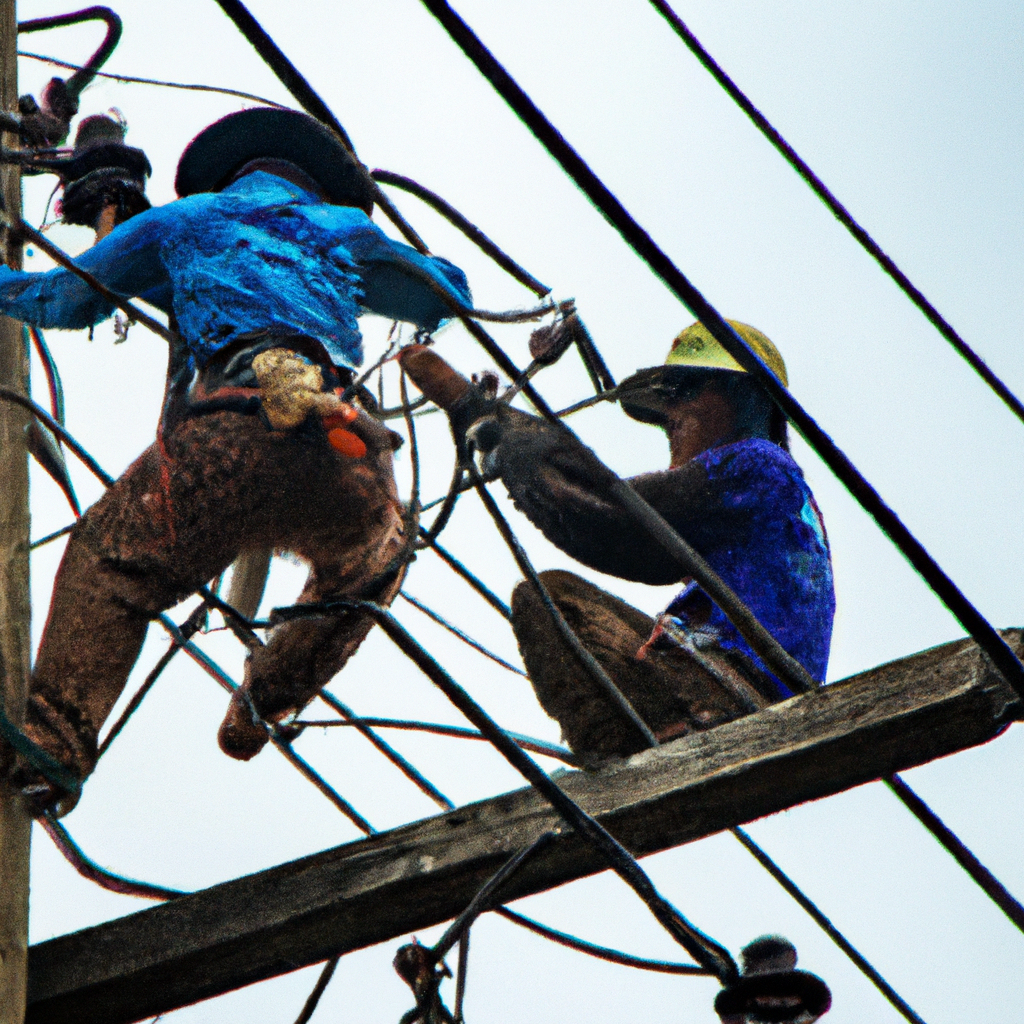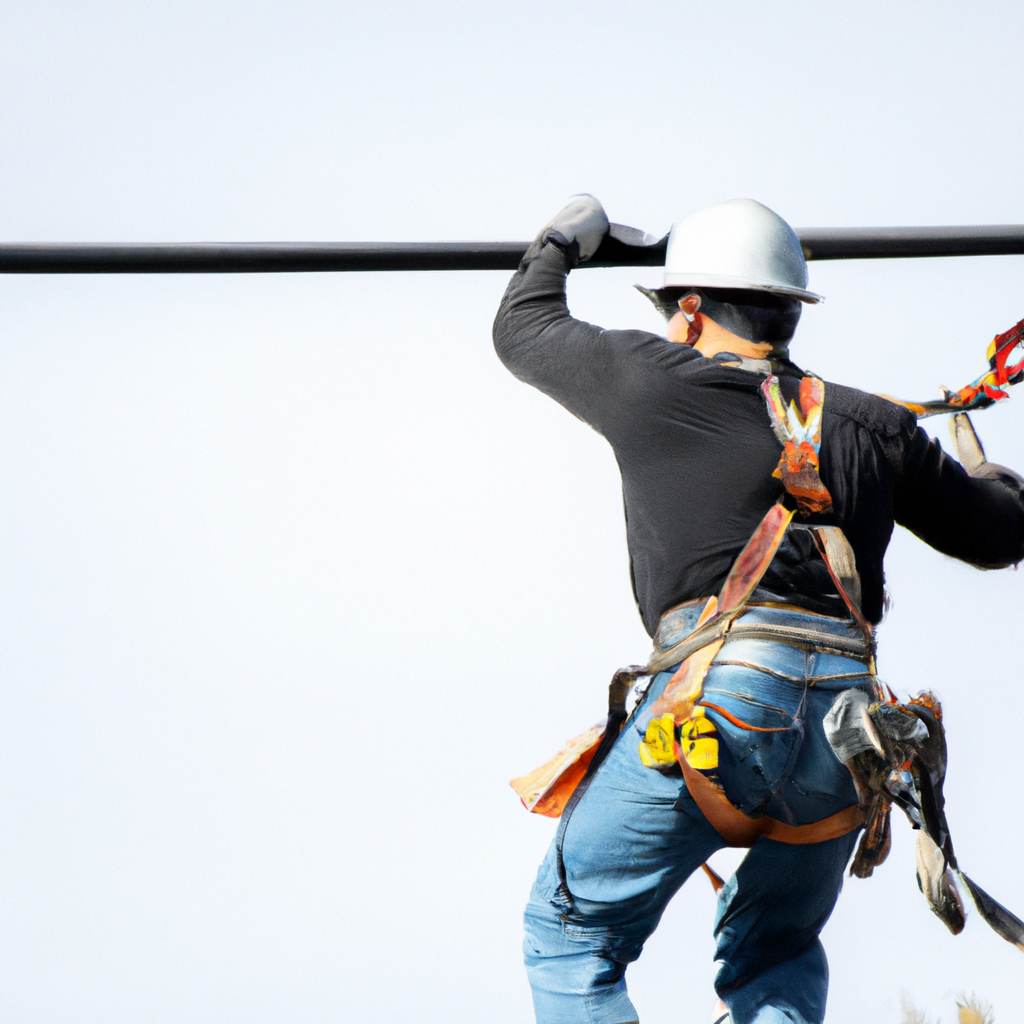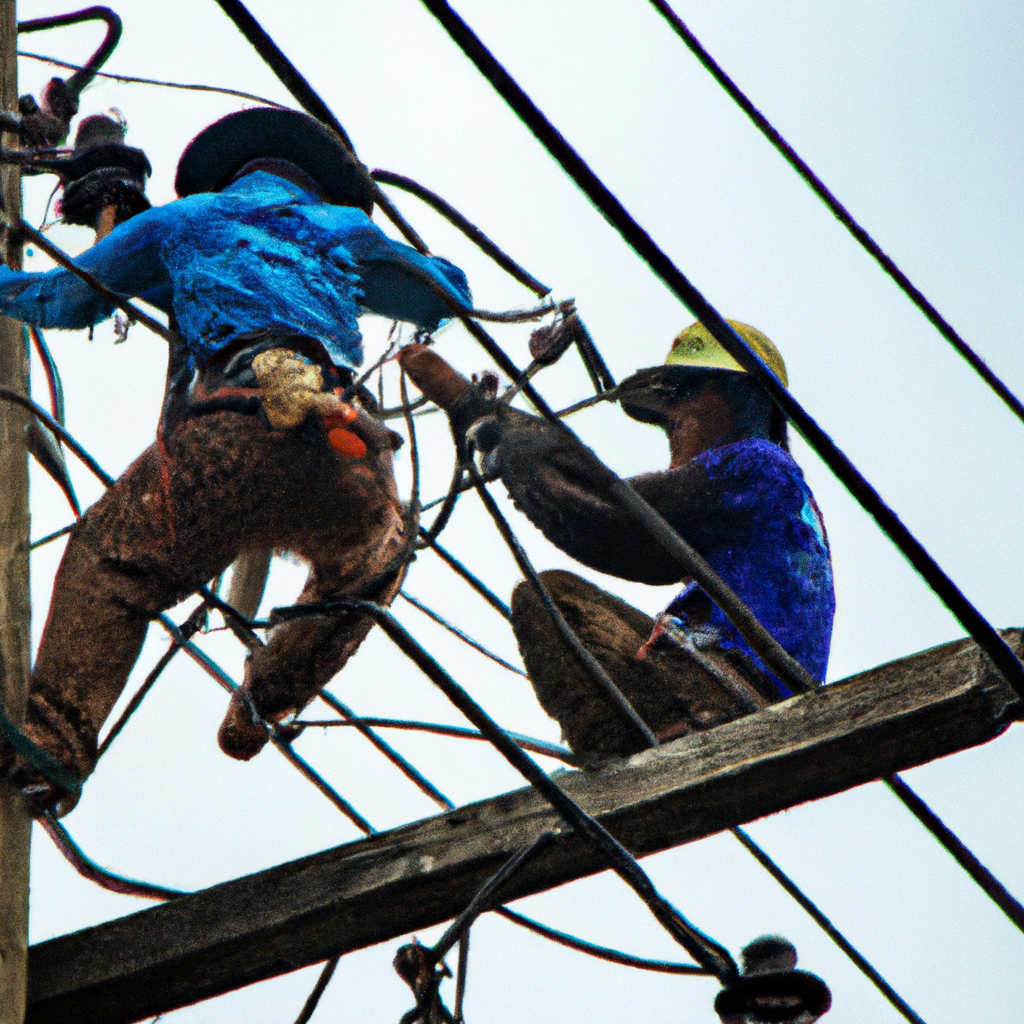Linemen, the unsung heroes who work tirelessly to maintain and repair power lines, have always been associated with scaling towering poles. But is climbing a prerequisite for all linemen? In this article, we will explore the requirements and skills needed in the profession, uncovering the truth behind the common assumption that all linemen must be skilled climbers. So, put on your hard hat and buckle up as we take a closer look at the world of linemen and the diverse roles they play in keeping our communities powered up.

Overview of Linemen
Definition of lineman
A lineman is a skilled worker in the electrical and telecommunication industries who is responsible for the installation, repair, and maintenance of power lines and cables. These professionals play a crucial role in ensuring the reliable and efficient transfer of electricity and communication signals across our communities.
Responsibilities and tasks
Linemen are tasked with various responsibilities and tasks. They are responsible for constructing new power lines, poles, and transformers, as well as repairing and replacing damaged ones. Linemen also perform routine maintenance checks to ensure the safety and efficiency of the electrical system. They are trained to identify and troubleshoot electrical issues, and they often work in teams to ensure the timely completion of projects.
Different types of linemen
Linemen can be classified into different types based on their specialization and the area in which they work. Some common types of linemen include climbing linemen, ground linemen, transmission linemen, and distribution linemen. Each type of lineman has unique duties and responsibilities that contribute to the functioning of the electrical and telecommunication infrastructure.
Importance of Climbing for Linemen
Reasons why climbing is necessary
Climbing is an essential skill for linemen as it enables them to access and work on power lines and poles at various heights. Many electrical systems are installed overhead, requiring linemen to climb poles to perform tasks such as repairing damaged lines, installing new equipment, or conducting routine inspections. Without the ability to climb, linemen would be unable to carry out their crucial duties effectively.
Specific tasks that require climbing
Climbing allows linemen to perform a range of specific tasks. They may need to ascend power poles to install and maintain transformers, string electrical wires, or inspect transmission and distribution lines for any faults or damage. Climbing skills also come into play when linemen need to work on the top of transmission towers or scale tall structures to install or repair telecommunication equipment. Therefore, climbing is a fundamental aspect of a lineman’s job.
Safety considerations for climbing
While climbing is an integral part of a lineman’s job, it also comes with inherent risks. Linemen must adhere to strict safety protocols and guidelines to ensure their well-being. They must wear appropriate safety gear, such as harnesses and helmets, and utilize fall protection equipment when climbing. Regular safety training and awareness are vital to minimize the risk of accidents and injuries while working at heights. By following safety protocols, linemen can carry out their tasks with confidence and mitigate the potential dangers of climbing.
Physical Requirements for Climbing
Strength and endurance
Climbing requires significant physical strength and endurance. Linemen must have the upper body strength to pull themselves up the poles and maintain their balance while working. They need strong arms, shoulders, and back muscles to support their body weight when climbing and performing tasks at heights. Additionally, linemen need endurance to sustain their physical exertion throughout the day, as they often work in challenging weather conditions and environments.
Balance and coordination
Maintaining balance and coordination is crucial for linemen while climbing and working on power lines. They must have a good sense of balance to traverse poles and maneuver themselves safely at heights. Coordination is also vital to handle tools and equipment effectively while working on elevated structures. Linemen must possess excellent hand-eye coordination to ensure precise and accurate movements when performing tasks like tightening bolts or connecting wires.
Physical fitness standards
Given the demanding nature of their job, linemen may be required to meet certain physical fitness standards. These standards ensure that linemen are physically capable of carrying out their duties safely and effectively. Fitness assessments may include tests of strength, endurance, agility, and flexibility. Being in good physical shape not only reduces the risk of accidents and injuries but also enhances a lineman’s overall performance and productivity in the field.
Training and Certification
Importance of training
Training is vital for linemen to acquire the necessary skills and knowledge to perform their jobs effectively. Proper training enables linemen to understand safety protocols, learn climbing techniques, and develop expertise in working with electrical equipment. Training programs also focus on teaching linemen about electrical systems, hazard identification, and emergency response. By investing in training, linemen can enhance their professional competence and contribute to a safer and more efficient electrical infrastructure.
Specific courses and programs
Various courses and programs cater to the specific training needs of linemen. These programs often include theoretical and hands-on training to ensure a well-rounded education. Linemen may undergo training in electrical theory, pole climbing techniques, electrical safety practices, and equipment operation. Some training institutes and organizations offer apprenticeship programs where aspiring linemen can gain valuable on-the-job training under the supervision of experienced professionals.
Certifications required for climbing
To climb and work on power lines, linemen are often required to obtain specific certifications. These certifications validate a lineman’s competence and adherence to safety standards. Examples of certifications include the Journeyman Lineman Certification, which demonstrates proficiency in various aspects of lineman work, and the Occupational Safety and Health Administration (OSHA) 10-Hour and 30-Hour Training Certifications, which ensure linemen are well-versed in safety regulations. Linemen must stay up to date with the necessary certifications to remain qualified and employable in their field.

Alternative Methods for Working at Heights
Equipment and tools for aerial work
While climbing is a fundamental aspect of lineman work, alternative methods are also available for working at heights. Linemen can utilize specialized equipment and tools designed for aerial work, which offer increased safety and efficiency. For example, bucket trucks are equipped with hydraulically operated aerial platforms that allow linemen to access elevated structures without climbing. The use of these vehicles reduces physical strain and enhances productivity for certain tasks.
Aerial lifts and platforms
Aerial lifts and platforms provide linemen with a secure and stable working platform at heights. These devices can be extended vertically and horizontally, allowing linemen to reach even the most challenging locations. Aerial lifts are particularly useful for conducting inspections, maintenance, and repairs on power lines, poles, and towers. They provide a safer alternative to climbing and minimize the risks associated with working at heights.
Use of drones and robotics
Advances in technology have also brought about the use of drones and robotics in the lineman industry. Drones equipped with cameras and sensors can be deployed to inspect power lines and equipment, providing valuable visual data without the need for climbing. Robotics, such as robotic arms, can assist linemen in performing specific tasks with precision and efficiency. These alternative methods offer increased safety and can complement traditional climbing techniques in certain situations.
Job Specializations within Linework
Climbing linemen
Climbing linemen specialize in performing tasks that involve climbing and working at heights. They are skilled in safely ascending power poles, towers, or structures using climbing gear. Climbing linemen are responsible for tasks such as installing and maintaining overhead power lines, repairing damaged cables, and conducting routine inspections. Their expertise in climbing and working at heights is crucial for ensuring the reliability and safety of the electrical infrastructure.
Ground linemen
Ground linemen focus on tasks that do not require climbing structures. They work primarily on the ground, assisting climbing linemen and handling tasks such as digging holes, trenching, and laying underground cables. Ground linemen are responsible for connecting cables, grounding systems, and installing transformers and switches. Their role complements the work of climbing linemen and contributes to the overall functioning of the electrical system.
Transmission linemen
Transmission linemen specialize in working on high-voltage transmission lines. They are trained to handle the unique challenges associated with the transmission of electricity over long distances. Transmission linemen are responsible for installing, maintaining, and troubleshooting transmission lines and associated equipment. They work on tall towers and structures to ensure the efficient transfer of electricity across vast areas.
Distribution linemen
Distribution linemen focus on the distribution of electricity from substations to individual customers. They are responsible for installing, repairing, and maintaining distribution lines, transformers, and other distribution equipment. Distribution linemen work on power poles and structures in residential, commercial, and industrial areas, ensuring the safe and reliable delivery of electricity to end-users. Their work is critical in maintaining electricity supply to homes, businesses, and essential services.
Career Opportunities for Non-Climbing Linemen
Roles and responsibilities
Non-climbing linemen have various career opportunities within the industry. They are involved in tasks such as equipment maintenance, troubleshooting electrical issues, and coordinating projects. They may specialize in areas such as equipment testing, metering, or substation maintenance. Non-climbing linemen may also work in supervisory or management roles, overseeing teams of linemen and ensuring the smooth operation of electrical systems.
Skills and qualifications needed
To excel as a non-climbing lineman, individuals typically need a strong foundational knowledge of electrical systems and equipment. They must possess problem-solving skills and the ability to analyze complex electrical issues. Non-climbing linemen must also have good communication and interpersonal skills to coordinate with other team members and stakeholders. Depending on the specific role, qualifications such as an associate’s or bachelor’s degree in electrical engineering or a related field may be required.
Advancement prospects
Non-climbing linemen can explore numerous opportunities for career advancement. With experience and additional training, they can move into more specialized roles within the electrical and telecommunication industry. Advancement may include becoming a supervisor, project manager, or electrical engineer. Non-climbing linemen can also pursue further certifications or education to expand their knowledge and skills and enhance their career prospects.
Challenges and Risks of Climbing
Workplace hazards
Climbing poses various workplace hazards that linemen must be cautious of. These hazards include the risk of falls, electrical shocks or burns, and exposure to extreme weather conditions. Linemen must be aware of their surroundings and follow safety protocols to avoid accidents. Hazards such as bee stings, snake bites, or encounters with wild animals may also be present in certain geographic locations. Linemen must remain vigilant and take necessary precautions to mitigate these risks.
Injury risks
The physical nature of climbing exposes linemen to the risk of injuries. Falls from heights can result in severe injuries or fatalities. Other common injuries include strains, sprains, cuts, and bruises that can occur when climbing or maneuvering on poles. Linemen are also at risk of electrical burns or shock if they come into contact with live wires or improperly grounded equipment. Proper training, safety gear, and adherence to safety protocols are essential in minimizing injury risks.
Safety precautions
To ensure their safety, linemen must adhere to strict safety precautions. This includes wearing appropriate personal protective equipment (PPE) such as helmets, gloves, and safety harnesses. Linemen must undergo regular safety training to stay updated on best practices and regulations. They must also be vigilant about inspecting equipment and tools before each use, and report any defects or malfunctioning equipment. Open communication, hazard identification, and risk assessments are fundamental to maintaining a safe working environment.
Job Satisfaction and Rewards
Sense of accomplishment
Linemen often experience a strong sense of accomplishment in their work. They play a crucial role in maintaining the integrity of the electrical and telecommunication systems that power our communities. Being able to solve complex electrical problems, restore power during outages, and contribute to the growth and development of the infrastructure provides linemen with a sense of pride and fulfillment in their profession.
Job stability and salary
Linemen enjoy a high level of job stability due to the essential nature of their work. The demand for skilled linemen remains steady, ensuring long-term career prospects. Additionally, linemen often receive competitive salaries that reflect the physical demands and specialized skills required for the job. The combination of job stability and attractive compensation makes a career as a lineman financially rewarding.
Future prospects and demand
The future prospects for linemen are promising. As our reliance on electricity and communication systems continues to grow, the demand for linemen is expected to increase. Advancements in technology, such as the expansion of renewable energy sources, contribute to the need for skilled linemen in areas such as solar and wind power. Linemen who stay updated on industry trends and advancements can capitalize on new opportunities and enjoy a fulfilling, long-term career.
Conclusion
Climbing is a fundamental requirement for linemen, enabling them to carry out essential tasks in the electrical and telecommunication industries. While climbing poses certain risks, linemen undergo rigorous training and adhere to safety precautions to ensure their well-being. Additionally, alternative methods and tools are available to enhance safety and efficiency while working at heights. The lineman profession offers a variety of career opportunities, both climbing and non-climbing roles, with promising prospects for advancement and job satisfaction. Considerations such as physical fitness and commitment to safety should be taken into account by individuals interested in pursuing a career as a lineman. As linemen continue to play a vital role in maintaining our electrical infrastructure, their skills and expertise remain in high demand, making it a rewarding and fulfilling profession.




